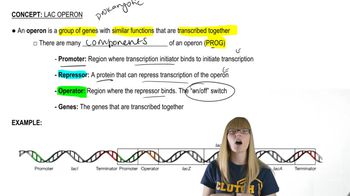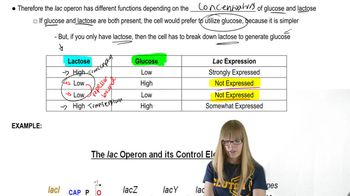- 1. Introduction to Genetics51m
- 2. Mendel's Laws of Inheritance3h 37m
- 3. Extensions to Mendelian Inheritance2h 41m
- 4. Genetic Mapping and Linkage2h 28m
- 5. Genetics of Bacteria and Viruses1h 21m
- 6. Chromosomal Variation1h 48m
- 7. DNA and Chromosome Structure56m
- 8. DNA Replication1h 10m
- 9. Mitosis and Meiosis1h 34m
- 10. Transcription1h 0m
- 11. Translation58m
- 12. Gene Regulation in Prokaryotes1h 19m
- 13. Gene Regulation in Eukaryotes44m
- 14. Genetic Control of Development44m
- 15. Genomes and Genomics1h 50m
- 16. Transposable Elements47m
- 17. Mutation, Repair, and Recombination1h 6m
- 18. Molecular Genetic Tools19m
- 19. Cancer Genetics29m
- 20. Quantitative Genetics1h 26m
- 21. Population Genetics50m
- 22. Evolutionary Genetics29m
Four independent lac⁻ mutants (mutants A to D) are isolated in haploid strains of E. coli. The strains have the following phenotypic characteristics:
Mutant A is lac⁻, but transcription1 of operon genes is induced by lactose.
Mutant B is lac⁻ and has uninducible2 transcription of operon genes.
Mutant C is lac⁺ and has constitutive3 transcription of operon genes.
Mutant D is lac⁺ and has constitutive3 transcription of operon genes.
A microbiologist develops donor and recipient varieties of each mutant strain and crosses them with the results shown below. The table indicates whether inducible, constitutive, or noninducible transcription occurs, along with and growth habit for each partial diploid. Assume each strain has a single mutation.
Mating Transcription and Growth
A × B lac⁻
A × C lac⁺, inducible
A × D lac⁺, constitutive
B × C lac⁺, inducible
B × D lac⁺, constitutive
C × D lac⁺, constitutive
Use this information to identify which lac operon gene is mutated in each strain.
 Verified Solution
Verified Solution


